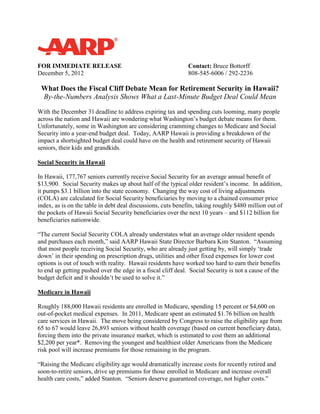
AARP: Impact of Fiscal Cliff on Hawaii's Kupuna
- 1. FOR IMMEDIATE RELEASE Contact: Bruce Bottorff December 5, 2012 808-545-6006 / 292-2236 What Does the Fiscal Cliff Debate Mean for Retirement Security in Hawaii? By-the-Numbers Analysis Shows What a Last-Minute Budget Deal Could Mean With the December 31 deadline to address expiring tax and spending cuts looming, many people across the nation and Hawaii are wondering what Washington’s budget debate means for them. Unfortunately, some in Washington are considering cramming changes to Medicare and Social Security into a year-end budget deal. Today, AARP Hawaii is providing a breakdown of the impact a shortsighted budget deal could have on the health and retirement security of Hawaii seniors, their kids and grandkids. Social Security in Hawaii In Hawaii, 177,767 seniors currently receive Social Security for an average annual benefit of $13,900. Social Security makes up about half of the typical older resident’s income. In addition, it pumps $3.1 billion into the state economy. Changing the way cost of living adjustments (COLA) are calculated for Social Security beneficiaries by moving to a chained consumer price index, as is on the table in debt deal discussions, cuts benefits, taking roughly $480 million out of the pockets of Hawaii Social Security beneficiaries over the next 10 years – and $112 billion for beneficiaries nationwide. “The current Social Security COLA already understates what an average older resident spends and purchases each month,” said AARP Hawaii State Director Barbara Kim Stanton. “Assuming that most people receiving Social Security, who are already just getting by, will simply ‘trade down’ in their spending on prescription drugs, utilities and other fixed expenses for lower cost options is out of touch with reality. Hawaii residents have worked too hard to earn their benefits to end up getting pushed over the edge in a fiscal cliff deal. Social Security is not a cause of the budget deficit and it shouldn’t be used to solve it.” Medicare in Hawaii Roughly 188,000 Hawaii residents are enrolled in Medicare, spending 15 percent or $4,600 on out-of-pocket medical expenses. In 2011, Medicare spent an estimated $1.76 billion on health care services in Hawaii. The move being considered by Congress to raise the eligibility age from 65 to 67 would leave 26,893 seniors without health coverage (based on current beneficiary data), forcing them into the private insurance market, which is estimated to cost them an additional $2,200 per year*. Removing the youngest and healthiest older Americans from the Medicare risk pool will increase premiums for those remaining in the program. “Raising the Medicare eligibility age would dramatically increase costs for recently retired and soon-to-retire seniors, drive up premiums for those enrolled in Medicare and increase overall health care costs,” added Stanton. “Seniors deserve guaranteed coverage, not higher costs.”
- 2. AARP looks forward to working with legislators on both sides of the aisle on proposals that strengthen Social Security and Medicare for all generations, but not by cramming changes to these vital programs into a last–minute deal that could harm all of us. *Kaiser Family Foundation study: http://www.kff.org/medicare/med032911nr.cfm AARP is a nonprofit, nonpartisan organization, with a membership of more than 37 million, that helps people 50+ have independence, choice and control in ways that are beneficial to them and society as a whole. AARP does not endorse candidates for public office or make contributions to either political campaigns or candidates. We produce AARP The Magazine, the definitive voice for Americans 50+ and the world's largest-circulation magazine; AARP Bulletin, the go-to news source for the 50+ audience; www.aarp.org; AARP VIVA, a bilingual lifestyle multimedia platform addressing the interests and needs of Hispanic Americans; and national television and radio programming including My Generation and Inside E Street. The AARP Foundation is an affiliated charity that provides security, protection, and empowerment to older persons in need with support from thousands of volunteers, donors, and sponsors. AARP has staffed offices in all 50 states, the District of Columbia, Puerto Rico, and the U.S. Virgin Islands. Learn more at www.aarp.org. ####
